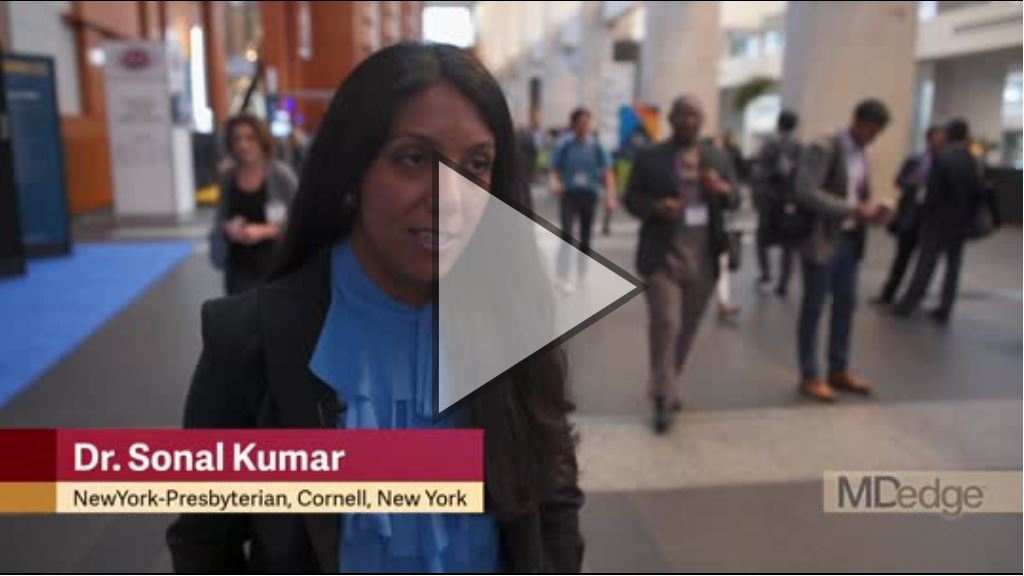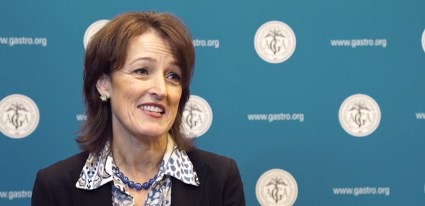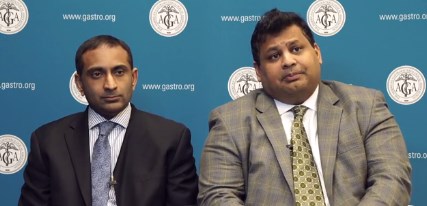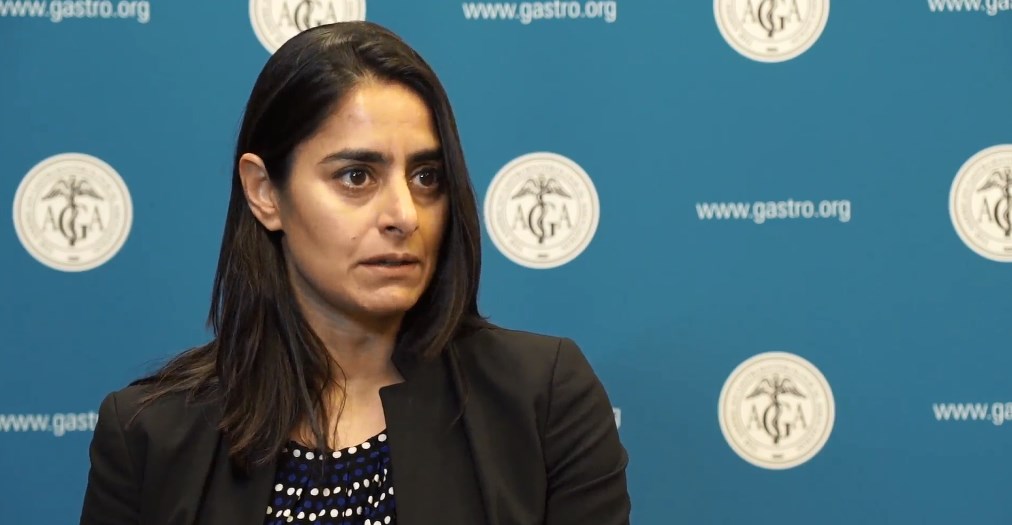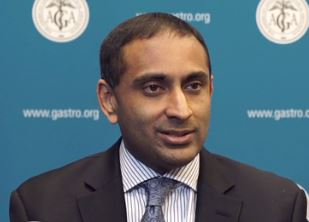User login
NAFLD patients with abnormal liver tests may not get statins when indicated
WASHINGTON – Though the liver safety of statins in patients with low-level liver enzyme elevations has long been established, some providers still hesitate to prescribe them to the patients with the conditions for which they are indicated.
Nonalcoholic fatty liver disease (NAFLD), hyperlipidemia, metabolic syndrome, and diabetes, which often co-occur, are also involved in cardiovascular disease. Cardiovascular disease is the most common cause of mortality in NAFLD, before liver disease.
Sonal Kumar, MD, MPH, of New York–Presbyterian Hospital described in a video interview at the annual Digestive Disease Week® a study she and her colleagues conducted to evaluate statin use in patients with hyperlipidemia by using data from the National Health and Nutrition Examination Survey during 2005-2014 (NHANES). Adult patients aged over 18 years were included if they did not have viral hepatitis, did not excessively consume alcohol, were not pregnant, and did not have transaminase levels over 500 IU/L.
Statin use was assessed in 136,833,627 participants by NHANES interviewers. Of these participants, 74.6% had hyperlipidemia (defined as LDL cholesterol greater than 130 mg/dL) and 93.5% were taking a statin. Patients with hyperlipidemia with abnormal alanine aminotransferase values were significantly less likely to be taking a statin (86.3% vs. 89.1%, P = .001). With multivariate analysis, abnormal ALT significantly decreased the odds of patients receiving a statin if they had diabetes (odds ratio, 0.75; 95% confidence interval, 0.57-0.99) when sex and age were controlled for.
Statins are underutilized in patients with NAFLD and diabetes, patient groups in whom they could help control cardiovascular disease risk factors, said Dr. Kumar. Providers need to be educated on the safety of statins in these patients to improve cardiovascular outcomes.
Dr. Kumar reported receiving support from Gilead and AbbVie.
WASHINGTON – Though the liver safety of statins in patients with low-level liver enzyme elevations has long been established, some providers still hesitate to prescribe them to the patients with the conditions for which they are indicated.
Nonalcoholic fatty liver disease (NAFLD), hyperlipidemia, metabolic syndrome, and diabetes, which often co-occur, are also involved in cardiovascular disease. Cardiovascular disease is the most common cause of mortality in NAFLD, before liver disease.
Sonal Kumar, MD, MPH, of New York–Presbyterian Hospital described in a video interview at the annual Digestive Disease Week® a study she and her colleagues conducted to evaluate statin use in patients with hyperlipidemia by using data from the National Health and Nutrition Examination Survey during 2005-2014 (NHANES). Adult patients aged over 18 years were included if they did not have viral hepatitis, did not excessively consume alcohol, were not pregnant, and did not have transaminase levels over 500 IU/L.
Statin use was assessed in 136,833,627 participants by NHANES interviewers. Of these participants, 74.6% had hyperlipidemia (defined as LDL cholesterol greater than 130 mg/dL) and 93.5% were taking a statin. Patients with hyperlipidemia with abnormal alanine aminotransferase values were significantly less likely to be taking a statin (86.3% vs. 89.1%, P = .001). With multivariate analysis, abnormal ALT significantly decreased the odds of patients receiving a statin if they had diabetes (odds ratio, 0.75; 95% confidence interval, 0.57-0.99) when sex and age were controlled for.
Statins are underutilized in patients with NAFLD and diabetes, patient groups in whom they could help control cardiovascular disease risk factors, said Dr. Kumar. Providers need to be educated on the safety of statins in these patients to improve cardiovascular outcomes.
Dr. Kumar reported receiving support from Gilead and AbbVie.
WASHINGTON – Though the liver safety of statins in patients with low-level liver enzyme elevations has long been established, some providers still hesitate to prescribe them to the patients with the conditions for which they are indicated.
Nonalcoholic fatty liver disease (NAFLD), hyperlipidemia, metabolic syndrome, and diabetes, which often co-occur, are also involved in cardiovascular disease. Cardiovascular disease is the most common cause of mortality in NAFLD, before liver disease.
Sonal Kumar, MD, MPH, of New York–Presbyterian Hospital described in a video interview at the annual Digestive Disease Week® a study she and her colleagues conducted to evaluate statin use in patients with hyperlipidemia by using data from the National Health and Nutrition Examination Survey during 2005-2014 (NHANES). Adult patients aged over 18 years were included if they did not have viral hepatitis, did not excessively consume alcohol, were not pregnant, and did not have transaminase levels over 500 IU/L.
Statin use was assessed in 136,833,627 participants by NHANES interviewers. Of these participants, 74.6% had hyperlipidemia (defined as LDL cholesterol greater than 130 mg/dL) and 93.5% were taking a statin. Patients with hyperlipidemia with abnormal alanine aminotransferase values were significantly less likely to be taking a statin (86.3% vs. 89.1%, P = .001). With multivariate analysis, abnormal ALT significantly decreased the odds of patients receiving a statin if they had diabetes (odds ratio, 0.75; 95% confidence interval, 0.57-0.99) when sex and age were controlled for.
Statins are underutilized in patients with NAFLD and diabetes, patient groups in whom they could help control cardiovascular disease risk factors, said Dr. Kumar. Providers need to be educated on the safety of statins in these patients to improve cardiovascular outcomes.
Dr. Kumar reported receiving support from Gilead and AbbVie.
REPORTING FROM DDW 2018
Key clinical point: Patients diagnosed with hyperlipidemia who had abnormal ALT levels were less likely to take a statin (86.3% vs. 89.1%, P = .001).
Major finding: Abnormal ALT significantly decreased the odds of patients receiving a statin if they had diabetes (odds ratio, 0.75; 95% confidence interval, 0.57-0.99) when sex and age were controlled for.
Data source: Data from 136,833,627 adult patients from the National Health and Nutrition Examination Survey collected during 2005-2014.
Disclosures: Dr. Kumar reported receiving support from Gilead and AbbVie.
VIDEO: Nanotechnology is making a mark in gastroenterology
BOSTON – Nanotechnology, though small in scale, is making a big difference in gastroenterology. Nanoparticles can deliver therapeutic compounds or enable other diagnostic tools, said Vadim Backman, PhD, the Walter Dill Scott Professor of Biomedical Engineering at Northwestern University, Chicago, in a video interview at the AGA Tech Summit, sponsored by the AGA Center for GI Innovation and Technology. Nanotechnology can treat disease by reprogramming gene expression or gene regulation. Nanoparticle formulations are FDA approved now for treatment of esophageal, colon, and pancreatic cancers, said Dr. Backman in a video interview, but the ability of nanotechnology to reprogram biological processes at the genetic level has researchers looking at treating inflammatory diseases and regenerating tissues.
BOSTON – Nanotechnology, though small in scale, is making a big difference in gastroenterology. Nanoparticles can deliver therapeutic compounds or enable other diagnostic tools, said Vadim Backman, PhD, the Walter Dill Scott Professor of Biomedical Engineering at Northwestern University, Chicago, in a video interview at the AGA Tech Summit, sponsored by the AGA Center for GI Innovation and Technology. Nanotechnology can treat disease by reprogramming gene expression or gene regulation. Nanoparticle formulations are FDA approved now for treatment of esophageal, colon, and pancreatic cancers, said Dr. Backman in a video interview, but the ability of nanotechnology to reprogram biological processes at the genetic level has researchers looking at treating inflammatory diseases and regenerating tissues.
BOSTON – Nanotechnology, though small in scale, is making a big difference in gastroenterology. Nanoparticles can deliver therapeutic compounds or enable other diagnostic tools, said Vadim Backman, PhD, the Walter Dill Scott Professor of Biomedical Engineering at Northwestern University, Chicago, in a video interview at the AGA Tech Summit, sponsored by the AGA Center for GI Innovation and Technology. Nanotechnology can treat disease by reprogramming gene expression or gene regulation. Nanoparticle formulations are FDA approved now for treatment of esophageal, colon, and pancreatic cancers, said Dr. Backman in a video interview, but the ability of nanotechnology to reprogram biological processes at the genetic level has researchers looking at treating inflammatory diseases and regenerating tissues.
FROM THE 2018 AGA TECH SUMMIT
VIDEO: Digital innovation, consumer point of view can solve clinical problems
BOSTON – Carla E. Small, MBA, senior director of innovation at Boston Children’s Hospital, addressed digital health care in a video interview at the AGA Tech Summit, sponsored by the AGA Center for GI Innovation and Technology. It is really just providing health care to patients in a digital world, she said, adding that she prefers the term “tech-enabled health care.” One up-and-coming example of this is the use of Alexa-type voice devices to do work and solve small clinical problems. Her program did a nationwide survey of pediatricians and found that half were interested in using voice technology. Artificial intelligence is another area of technology that Boston Children’s is using – in particular, they have created algorithms that help pediatricians analyze brain scans of young children, because so few pediatricians are trained in this area. The innovation program also has taken the digital world to pediatric patients in a program called Health Voyager in which children can take a virtual journey through their own diseased intestinal system.
BOSTON – Carla E. Small, MBA, senior director of innovation at Boston Children’s Hospital, addressed digital health care in a video interview at the AGA Tech Summit, sponsored by the AGA Center for GI Innovation and Technology. It is really just providing health care to patients in a digital world, she said, adding that she prefers the term “tech-enabled health care.” One up-and-coming example of this is the use of Alexa-type voice devices to do work and solve small clinical problems. Her program did a nationwide survey of pediatricians and found that half were interested in using voice technology. Artificial intelligence is another area of technology that Boston Children’s is using – in particular, they have created algorithms that help pediatricians analyze brain scans of young children, because so few pediatricians are trained in this area. The innovation program also has taken the digital world to pediatric patients in a program called Health Voyager in which children can take a virtual journey through their own diseased intestinal system.
BOSTON – Carla E. Small, MBA, senior director of innovation at Boston Children’s Hospital, addressed digital health care in a video interview at the AGA Tech Summit, sponsored by the AGA Center for GI Innovation and Technology. It is really just providing health care to patients in a digital world, she said, adding that she prefers the term “tech-enabled health care.” One up-and-coming example of this is the use of Alexa-type voice devices to do work and solve small clinical problems. Her program did a nationwide survey of pediatricians and found that half were interested in using voice technology. Artificial intelligence is another area of technology that Boston Children’s is using – in particular, they have created algorithms that help pediatricians analyze brain scans of young children, because so few pediatricians are trained in this area. The innovation program also has taken the digital world to pediatric patients in a program called Health Voyager in which children can take a virtual journey through their own diseased intestinal system.
FROM THE 20I8 AGA TECH SUMMIT
VIDEO: In 2018, the AGA Center for GI Innovation and Technology is going strong
BOSTON – The AGA Center for GI Innovation and Technology (CGIT) was founded 9 years ago to foster innovation in GI disease, according to Sri Komanduri, MD, AGAF, and V. Raman Muthusamy, MD, the current cochairs. The mandate is still the same, with the idea that CGIT will continue to provide support and resources to a wide variety of stakeholders throughout the daunting process of getting a new technology or product through funding and approval to reimbursement and adoption. Dr. Komanduri, the medical director of the GI laboratory and director of interventional endoscopy at Northwestern University in Chicago, emphasized the need to support the entire process from idea to adoption as a continuum that should not be handled by different silos – CGIT should be there every step of the way.
CGIT will concentrate on six main areas now, although Dr. Muthusamy, director of interventional endoscopy and general GI endoscopy at the University of California, Los Angeles, said in a video interview that they are flexible enough to work with any GI-applicable technology that will help practicing clinicians. These six areas are endoscopy for bariatric treatments, endoscopy for resection in place of surgery, endoscope reprocessing, interventional endoscopy, endoscopic reflux technology, and endoscopic diagnostic colorectal advances.
BOSTON – The AGA Center for GI Innovation and Technology (CGIT) was founded 9 years ago to foster innovation in GI disease, according to Sri Komanduri, MD, AGAF, and V. Raman Muthusamy, MD, the current cochairs. The mandate is still the same, with the idea that CGIT will continue to provide support and resources to a wide variety of stakeholders throughout the daunting process of getting a new technology or product through funding and approval to reimbursement and adoption. Dr. Komanduri, the medical director of the GI laboratory and director of interventional endoscopy at Northwestern University in Chicago, emphasized the need to support the entire process from idea to adoption as a continuum that should not be handled by different silos – CGIT should be there every step of the way.
CGIT will concentrate on six main areas now, although Dr. Muthusamy, director of interventional endoscopy and general GI endoscopy at the University of California, Los Angeles, said in a video interview that they are flexible enough to work with any GI-applicable technology that will help practicing clinicians. These six areas are endoscopy for bariatric treatments, endoscopy for resection in place of surgery, endoscope reprocessing, interventional endoscopy, endoscopic reflux technology, and endoscopic diagnostic colorectal advances.
BOSTON – The AGA Center for GI Innovation and Technology (CGIT) was founded 9 years ago to foster innovation in GI disease, according to Sri Komanduri, MD, AGAF, and V. Raman Muthusamy, MD, the current cochairs. The mandate is still the same, with the idea that CGIT will continue to provide support and resources to a wide variety of stakeholders throughout the daunting process of getting a new technology or product through funding and approval to reimbursement and adoption. Dr. Komanduri, the medical director of the GI laboratory and director of interventional endoscopy at Northwestern University in Chicago, emphasized the need to support the entire process from idea to adoption as a continuum that should not be handled by different silos – CGIT should be there every step of the way.
CGIT will concentrate on six main areas now, although Dr. Muthusamy, director of interventional endoscopy and general GI endoscopy at the University of California, Los Angeles, said in a video interview that they are flexible enough to work with any GI-applicable technology that will help practicing clinicians. These six areas are endoscopy for bariatric treatments, endoscopy for resection in place of surgery, endoscope reprocessing, interventional endoscopy, endoscopic reflux technology, and endoscopic diagnostic colorectal advances.
FROM THE 2018 AGA TECH SUMMIT
VIDEO: It’s all about improving the patient experience
BOSTON – “When I assess a new technology,” said V. Raman Muthusamy, MD, chair of the AGA Center for GI Innovation and Technology (CGIT), “I look for three things” – it should allow us to do something we couldn’t do before, give better outcomes and/or do the procedure less invasively, or provide cost savings. Ideally, he said during an interview at the AGA Tech Summit, it should do all three. Dr. Muthusamy, director of interventional endoscopy and general GI endoscopy at the University of California, Los Angeles, said one of the goals of the CGIT is to keep physicians up to date on new technologies, but he recommends all physicians assess the data on new technologies and weigh the advantages before incorporating a new device into their practice. Better diagnostic tools and novel therapeutics should improve the patient experience.
BOSTON – “When I assess a new technology,” said V. Raman Muthusamy, MD, chair of the AGA Center for GI Innovation and Technology (CGIT), “I look for three things” – it should allow us to do something we couldn’t do before, give better outcomes and/or do the procedure less invasively, or provide cost savings. Ideally, he said during an interview at the AGA Tech Summit, it should do all three. Dr. Muthusamy, director of interventional endoscopy and general GI endoscopy at the University of California, Los Angeles, said one of the goals of the CGIT is to keep physicians up to date on new technologies, but he recommends all physicians assess the data on new technologies and weigh the advantages before incorporating a new device into their practice. Better diagnostic tools and novel therapeutics should improve the patient experience.
BOSTON – “When I assess a new technology,” said V. Raman Muthusamy, MD, chair of the AGA Center for GI Innovation and Technology (CGIT), “I look for three things” – it should allow us to do something we couldn’t do before, give better outcomes and/or do the procedure less invasively, or provide cost savings. Ideally, he said during an interview at the AGA Tech Summit, it should do all three. Dr. Muthusamy, director of interventional endoscopy and general GI endoscopy at the University of California, Los Angeles, said one of the goals of the CGIT is to keep physicians up to date on new technologies, but he recommends all physicians assess the data on new technologies and weigh the advantages before incorporating a new device into their practice. Better diagnostic tools and novel therapeutics should improve the patient experience.
FROM THE 2018 AGA TECH SUMMIT
VIDEO: It is an exciting time in obesity treatment
BOSTON – For those in obesity treatment, things are looking up, said Reem Z. Sharaiha, MD, MSc, in a video interview at the AGA Tech Summit, sponsored by the AGA Center for GI Innovation and Technology. There are several new therapies to choose from, said Dr. Sharaiha, assistant professor of medicine at Cornell University, New York – and a variety of therapies coming down the pipeline. The key is to choose the right treatment, or right combination of treatments – surgical, endoscopic, or medical – for the right patient at the right time and to follow up. Obesity is a chronic disease that needs long-term, team treatment. With obesity treatments there is sometimes a trade-off between risk and results, but the innovations coming along may balance that risk-results equation for some patients, she said.
BOSTON – For those in obesity treatment, things are looking up, said Reem Z. Sharaiha, MD, MSc, in a video interview at the AGA Tech Summit, sponsored by the AGA Center for GI Innovation and Technology. There are several new therapies to choose from, said Dr. Sharaiha, assistant professor of medicine at Cornell University, New York – and a variety of therapies coming down the pipeline. The key is to choose the right treatment, or right combination of treatments – surgical, endoscopic, or medical – for the right patient at the right time and to follow up. Obesity is a chronic disease that needs long-term, team treatment. With obesity treatments there is sometimes a trade-off between risk and results, but the innovations coming along may balance that risk-results equation for some patients, she said.
BOSTON – For those in obesity treatment, things are looking up, said Reem Z. Sharaiha, MD, MSc, in a video interview at the AGA Tech Summit, sponsored by the AGA Center for GI Innovation and Technology. There are several new therapies to choose from, said Dr. Sharaiha, assistant professor of medicine at Cornell University, New York – and a variety of therapies coming down the pipeline. The key is to choose the right treatment, or right combination of treatments – surgical, endoscopic, or medical – for the right patient at the right time and to follow up. Obesity is a chronic disease that needs long-term, team treatment. With obesity treatments there is sometimes a trade-off between risk and results, but the innovations coming along may balance that risk-results equation for some patients, she said.
REPORTING FROM 2018 AGA TECH SUMMIT
VIDEO: Organ-sparing resection techniques should be way of the future
BOSTON – Organ-sparing resection techniques that remove lesions from the esophagus, stomach, and colon are being developed, Amrita Sethi, MD, said in a video interview at the 2018 AGA Tech Summit, sponsored by the AGA Center for GI Innovation and Technology.
Dr. Sethi, an assistant professor of medicine at Columbia University Medical Center, New York, said these techniques improve patient outcomes by maintaining organ integrity, whereas older techniques often led to removal of large amounts of tissue around lesions. And while organ-sparing techniques reduce recovery time and hospital stays, training and reimbursement for these procedures remain problematic. As much as new endoscopic package devices are needed from industry to make these procedures easier, automated or artificial intelligence is needed to help make the decisions on when these techniques are applicable. Reimbursement structures are needed so that these procedures make financial sense, she noted.
We live in a health care system now, Dr. Sethi said, in which benign polyps of the colon are being sent for surgical resection when what is really needed is referral for more advanced endoscopic treatment. This is a matter of training, and perhaps showing through comparative trials that organ-sparing techniques cost less and improve patient outcomes.
BOSTON – Organ-sparing resection techniques that remove lesions from the esophagus, stomach, and colon are being developed, Amrita Sethi, MD, said in a video interview at the 2018 AGA Tech Summit, sponsored by the AGA Center for GI Innovation and Technology.
Dr. Sethi, an assistant professor of medicine at Columbia University Medical Center, New York, said these techniques improve patient outcomes by maintaining organ integrity, whereas older techniques often led to removal of large amounts of tissue around lesions. And while organ-sparing techniques reduce recovery time and hospital stays, training and reimbursement for these procedures remain problematic. As much as new endoscopic package devices are needed from industry to make these procedures easier, automated or artificial intelligence is needed to help make the decisions on when these techniques are applicable. Reimbursement structures are needed so that these procedures make financial sense, she noted.
We live in a health care system now, Dr. Sethi said, in which benign polyps of the colon are being sent for surgical resection when what is really needed is referral for more advanced endoscopic treatment. This is a matter of training, and perhaps showing through comparative trials that organ-sparing techniques cost less and improve patient outcomes.
BOSTON – Organ-sparing resection techniques that remove lesions from the esophagus, stomach, and colon are being developed, Amrita Sethi, MD, said in a video interview at the 2018 AGA Tech Summit, sponsored by the AGA Center for GI Innovation and Technology.
Dr. Sethi, an assistant professor of medicine at Columbia University Medical Center, New York, said these techniques improve patient outcomes by maintaining organ integrity, whereas older techniques often led to removal of large amounts of tissue around lesions. And while organ-sparing techniques reduce recovery time and hospital stays, training and reimbursement for these procedures remain problematic. As much as new endoscopic package devices are needed from industry to make these procedures easier, automated or artificial intelligence is needed to help make the decisions on when these techniques are applicable. Reimbursement structures are needed so that these procedures make financial sense, she noted.
We live in a health care system now, Dr. Sethi said, in which benign polyps of the colon are being sent for surgical resection when what is really needed is referral for more advanced endoscopic treatment. This is a matter of training, and perhaps showing through comparative trials that organ-sparing techniques cost less and improve patient outcomes.
REPORTING FROM 2018 AGA TECH SUMMIT
VIDEO: Digital health technologies are here to be embraced
BOSTON – One of the innovations in gastroenterology that is used on a day-to-day basis is digital technology, said Sri Komanduri, MD, in a video interview at the 2018 AGA Tech Summit, which is sponsored by the AGA Center for GI Innovation and Technology.
Everything from Internet rate-your-doctor sites to bowel prep apps and EHRs qualify as digital health technology, said Dr. Komanduri, the medical director of the GI laboratory and director of interventional endoscopy at Northwestern University in Chicago and vice chair of the AGA Center for GI Innovation and Technology.
Digital technology can facilitate endoscopy procedures, help patients communicate with their doctors about chronic conditions, and help patients better understand their illness. The role of the physician is to embrace those technologies that improve the quality of care.
BOSTON – One of the innovations in gastroenterology that is used on a day-to-day basis is digital technology, said Sri Komanduri, MD, in a video interview at the 2018 AGA Tech Summit, which is sponsored by the AGA Center for GI Innovation and Technology.
Everything from Internet rate-your-doctor sites to bowel prep apps and EHRs qualify as digital health technology, said Dr. Komanduri, the medical director of the GI laboratory and director of interventional endoscopy at Northwestern University in Chicago and vice chair of the AGA Center for GI Innovation and Technology.
Digital technology can facilitate endoscopy procedures, help patients communicate with their doctors about chronic conditions, and help patients better understand their illness. The role of the physician is to embrace those technologies that improve the quality of care.
BOSTON – One of the innovations in gastroenterology that is used on a day-to-day basis is digital technology, said Sri Komanduri, MD, in a video interview at the 2018 AGA Tech Summit, which is sponsored by the AGA Center for GI Innovation and Technology.
Everything from Internet rate-your-doctor sites to bowel prep apps and EHRs qualify as digital health technology, said Dr. Komanduri, the medical director of the GI laboratory and director of interventional endoscopy at Northwestern University in Chicago and vice chair of the AGA Center for GI Innovation and Technology.
Digital technology can facilitate endoscopy procedures, help patients communicate with their doctors about chronic conditions, and help patients better understand their illness. The role of the physician is to embrace those technologies that improve the quality of care.
FROM THE 2018 AGA TECH SUMMIT
VIDEO: Bile acid malabsorption as a cause of chronic diarrhea
CHICAGO – Bile acid malabsorption increasingly is recognized as a cause of persistent, chronic diarrhea, but patients often receive suboptimal treatment because medical and public awareness is low, Julian Walters, MD, of Imperial College London, said at Digestive Disease Week®.
Members of two patient support groups in the United Kingdom were invited to complete an online survey to provide information on how this condition affects them. The first 100 responses were analyzed. The majority of respondents were female (91). More than 35 respondents were diagnosed after the age of 50 years, and 35 felt their condition had not been taken seriously by multiple practitioners prior to their eventual diagnosis, Dr. Walters reported.
Two-thirds of respondents had been diagnosed with irritable bowel syndrome; the majority (68) of these had more than 10 interactions with medical professionals before being diagnosed with bile acid malabsorption.
Once appropriately diagnosed, most respondents reported doing very well on drugs such as cholestyramine and colesevelam, Dr. Walters said. He stressed that mental health issues are an important part of this condition because of its pervasive effects on daily life.
He discusses the survey and bile acid malabsorption in this video interview.
Dr. Walters disclosed that he has been a consultant to or has received research funds from GE Healthcare, Intercept, Albireo, and Novartis.
Digestive Disease Week® is jointly sponsored by the American Association for the Study of Liver Diseases (AASLD), the American Gastroenterological Association (AGA) Institute, the American Society for Gastrointestinal Endoscopy (ASGE), and the Society for Surgery of the Alimentary Tract (SSAT).
CHICAGO – Bile acid malabsorption increasingly is recognized as a cause of persistent, chronic diarrhea, but patients often receive suboptimal treatment because medical and public awareness is low, Julian Walters, MD, of Imperial College London, said at Digestive Disease Week®.
Members of two patient support groups in the United Kingdom were invited to complete an online survey to provide information on how this condition affects them. The first 100 responses were analyzed. The majority of respondents were female (91). More than 35 respondents were diagnosed after the age of 50 years, and 35 felt their condition had not been taken seriously by multiple practitioners prior to their eventual diagnosis, Dr. Walters reported.
Two-thirds of respondents had been diagnosed with irritable bowel syndrome; the majority (68) of these had more than 10 interactions with medical professionals before being diagnosed with bile acid malabsorption.
Once appropriately diagnosed, most respondents reported doing very well on drugs such as cholestyramine and colesevelam, Dr. Walters said. He stressed that mental health issues are an important part of this condition because of its pervasive effects on daily life.
He discusses the survey and bile acid malabsorption in this video interview.
Dr. Walters disclosed that he has been a consultant to or has received research funds from GE Healthcare, Intercept, Albireo, and Novartis.
Digestive Disease Week® is jointly sponsored by the American Association for the Study of Liver Diseases (AASLD), the American Gastroenterological Association (AGA) Institute, the American Society for Gastrointestinal Endoscopy (ASGE), and the Society for Surgery of the Alimentary Tract (SSAT).
CHICAGO – Bile acid malabsorption increasingly is recognized as a cause of persistent, chronic diarrhea, but patients often receive suboptimal treatment because medical and public awareness is low, Julian Walters, MD, of Imperial College London, said at Digestive Disease Week®.
Members of two patient support groups in the United Kingdom were invited to complete an online survey to provide information on how this condition affects them. The first 100 responses were analyzed. The majority of respondents were female (91). More than 35 respondents were diagnosed after the age of 50 years, and 35 felt their condition had not been taken seriously by multiple practitioners prior to their eventual diagnosis, Dr. Walters reported.
Two-thirds of respondents had been diagnosed with irritable bowel syndrome; the majority (68) of these had more than 10 interactions with medical professionals before being diagnosed with bile acid malabsorption.
Once appropriately diagnosed, most respondents reported doing very well on drugs such as cholestyramine and colesevelam, Dr. Walters said. He stressed that mental health issues are an important part of this condition because of its pervasive effects on daily life.
He discusses the survey and bile acid malabsorption in this video interview.
Dr. Walters disclosed that he has been a consultant to or has received research funds from GE Healthcare, Intercept, Albireo, and Novartis.
Digestive Disease Week® is jointly sponsored by the American Association for the Study of Liver Diseases (AASLD), the American Gastroenterological Association (AGA) Institute, the American Society for Gastrointestinal Endoscopy (ASGE), and the Society for Surgery of the Alimentary Tract (SSAT).
AT DDW
VIDEO: Innovation is important to the future of gastroenterology
BOSTON – Many of the disorders that gastroenterologists treat do not have very effective treatments, so there is lots of room for innovation, according to Dr. Sidhartha R. Sinha of Stanford (Calif.) University.
Gastroenterologists should get involved in innovation early because there is much to learn, he advised in a video interview at the 2016 AGA Tech Summit. It can be a tough business, but if one focuses on the clinical need and considers the number of patients who could benefit from such advances, then innovation can be a rewarding path to pursue, Dr. Sinha noted.
The AGA Tech Summit is sponsored by the AGA Center for GI Innovation and Technology.
The video associated with this article is no longer available on this site. Please view all of our videos on the MDedge YouTube channel
BOSTON – Many of the disorders that gastroenterologists treat do not have very effective treatments, so there is lots of room for innovation, according to Dr. Sidhartha R. Sinha of Stanford (Calif.) University.
Gastroenterologists should get involved in innovation early because there is much to learn, he advised in a video interview at the 2016 AGA Tech Summit. It can be a tough business, but if one focuses on the clinical need and considers the number of patients who could benefit from such advances, then innovation can be a rewarding path to pursue, Dr. Sinha noted.
The AGA Tech Summit is sponsored by the AGA Center for GI Innovation and Technology.
The video associated with this article is no longer available on this site. Please view all of our videos on the MDedge YouTube channel
BOSTON – Many of the disorders that gastroenterologists treat do not have very effective treatments, so there is lots of room for innovation, according to Dr. Sidhartha R. Sinha of Stanford (Calif.) University.
Gastroenterologists should get involved in innovation early because there is much to learn, he advised in a video interview at the 2016 AGA Tech Summit. It can be a tough business, but if one focuses on the clinical need and considers the number of patients who could benefit from such advances, then innovation can be a rewarding path to pursue, Dr. Sinha noted.
The AGA Tech Summit is sponsored by the AGA Center for GI Innovation and Technology.
The video associated with this article is no longer available on this site. Please view all of our videos on the MDedge YouTube channel
AT THE 2016 AGA TECH SUMMIT
